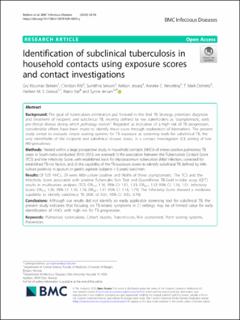Identification of subclinical tuberculosis in household contacts using exposure scores and contact investigations
Bekken, Gry Klouman; Ritz, Christian; Selvam, Sumithra; Jesuraj, Nelson; Hesseling, Anneke; Doherty, T. Mark; Grewal, Harleen; Vaz, Mario; Jenum, Synne
Journal article, Peer reviewed
Published version

Åpne
Permanent lenke
https://hdl.handle.net/11250/2762613Utgivelsesdato
2020-01-31Metadata
Vis full innførselSamlinger
- Department of Clinical Science [2317]
- Registrations from Cristin [9766]
Sammendrag
Background: The goal of tuberculosis elimination put forward in the End TB Strategy prioritizes diagnosis and treatment of incipient and subclinical TB, recently defined by key stakeholders as “asymptomatic, early pre-clinical disease during which pathology evolves”. Regarded as indicative of a high risk of TB progression, considerable efforts have been made to identify these cases through exploration of biomarkers. The present study aimed to evaluate simple scoring systems for TB exposure as screening tools for subclinical TB, the only identifiable of the incipient and subclinical disease states, in a contact investigation (CI) setting of low HIV-prevalence.
Methods: Nested within a large prospective study in household contacts (HHCs) of smear positive pulmonary TB cases in South-India conducted 2010–2012, we assessed 1) the association between the Tuberculosis Contact Score (TCS) and the Infectivity Score, with established tools for Mycobacterium tuberculosis (Mtb) infection, corrected for established TB risk factors, and 2) the capability of the TB exposure scores to identify subclinical TB defined by Mtb-culture positivity in sputum or gastric aspirate (subjects < 5 years) specimen.
Results: Of 525 HHCs, 29 were Mtb-culture positive and 96.6% of these asymptomatic. The TCS and the Infectivity Score associated with positive Tuberculin Skin Test and QuantiFeron TB-Gold In-tube assay (QFT) results in multivariate analyses (TCS: ORTST 1.16, 95% CI: 1.01, 1.33; ORQFT 1.33 95% CI: 1.16, 1.51. Infectivity Score: ORTST 1.39, 95% CI: 1.10, 1.76; ORQFT 1.41 95% CI: 1.16, 1.71). The Infectivity Score showed a moderate capability to identify subclinical TB (AUC of 0.61, 95% CI: 0.52, 0.70).
Conclusions: Although our results did not identify an easily applicable screening tool for subclinical TB, the present study indicates that focusing on TB-related symptoms in CI settings may be of limited value for early identification of HHCs with high risk for TB progression.
